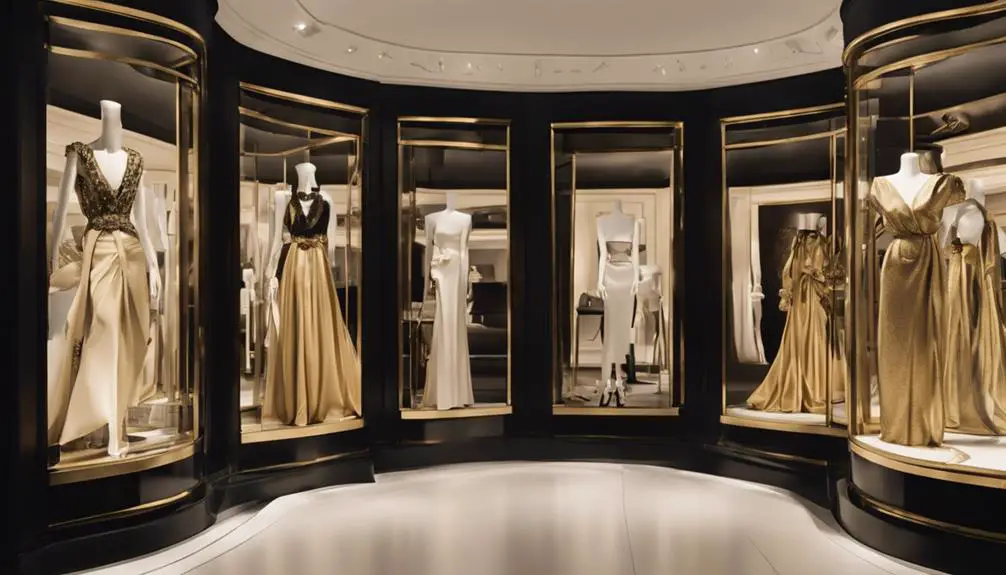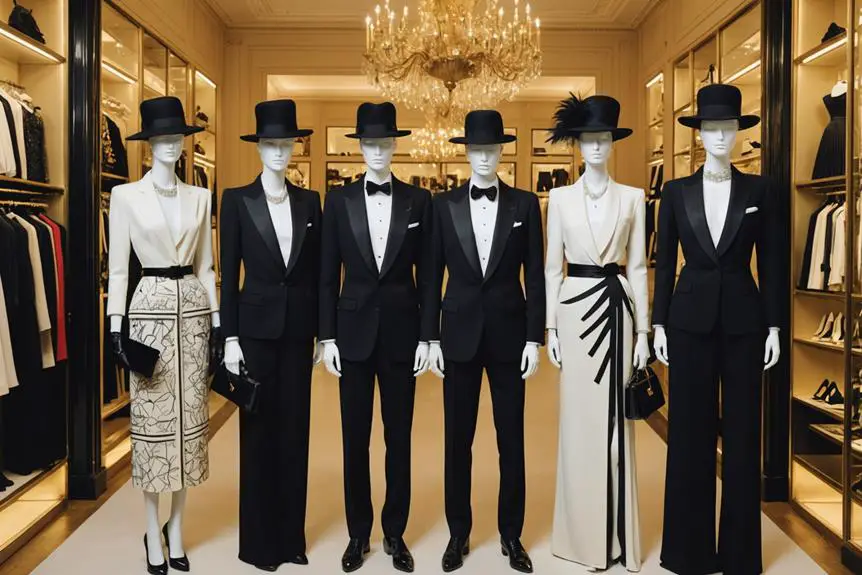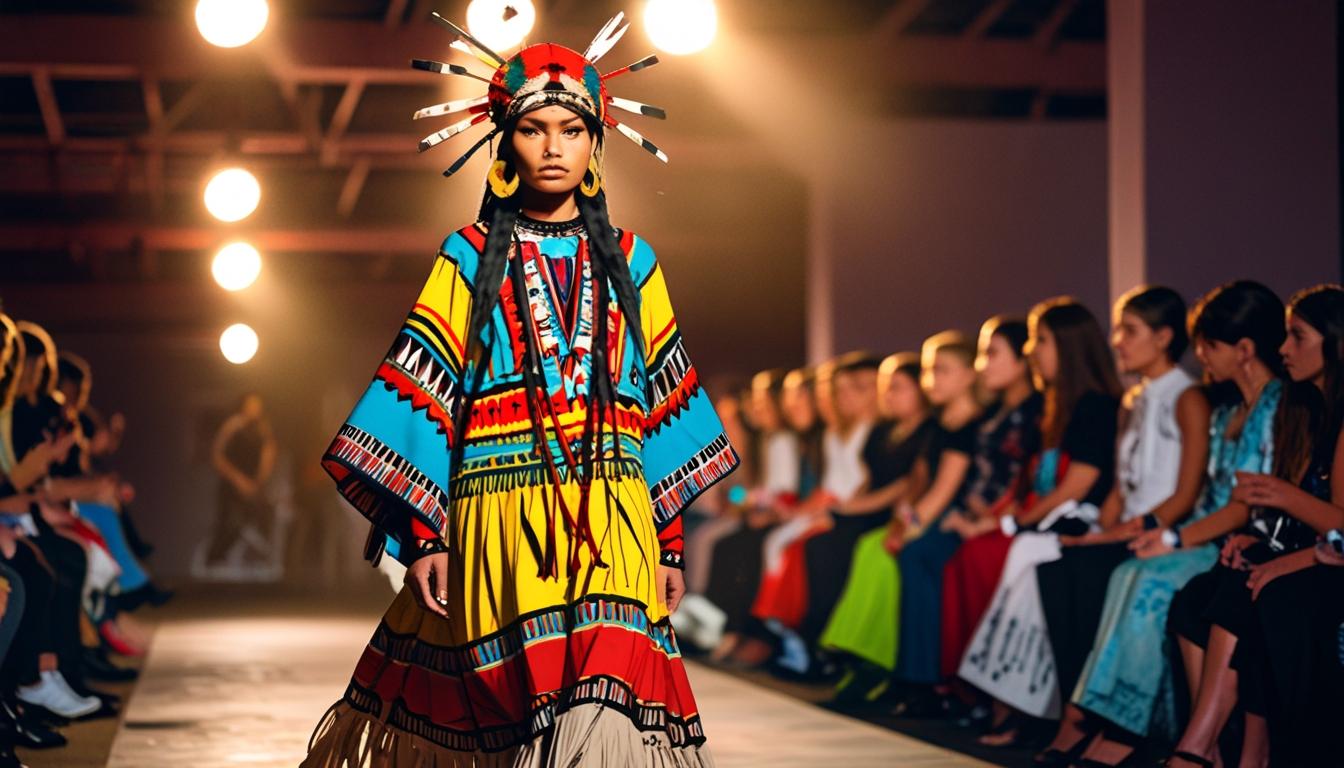Did you know that Yves Saint Laurent revolutionized women's fashion by introducing the tuxedo jacket for women in 1966, a bold move that reshaped gender norms? This iconic designer's name isn't just a label; it symbolizes a blend of individuality, heritage, and innovation. As you explore the layers behind his legacy, you'll uncover how his groundbreaking ideas continue to resonate in today's fashion landscape and what they reveal about the evolving definitions of style and identity. What might this mean for the future of fashion?
Significance of the Name

The name Yves Saint Laurent resonates deeply within the fashion world, symbolizing a blend of avant-garde creativity and timeless elegance. When you think of Yves, you're reminded of a designer who revolutionized women's wear, merging luxury with everyday wearability. His first name, "Yves," captures a personal touch, reflecting his belief in individuality and self-expression. He championed the idea that fashion should empower, not constrain, allowing each person to showcase their unique style.
Much like the historical journey of Gucci, which evolved through various cultural influences and styles, Yves Saint Laurent's work also reflects a transformative era in fashion, where personal expression became paramount the evolution of luxury fashion.
The surname "Saint Laurent" pays tribute to his rich French heritage, connecting him to a legacy of artistry and craftsmanship that's essential to Paris fashion history. This duality in his name isn't merely a label; it's a reflection of his commitment to sophistication and innovation. Through his work, he redefined haute couture, making it accessible while maintaining its luxurious nature.
As you explore the significance of the name Yves Saint Laurent, you'll discover how it became synonymous with elegance and high fashion. His influence continues to permeate the industry, inspiring countless designers who aspire to create with the same passion and purpose.
The establishment of the Yves Saint Laurent Museum in Paris further cements his legacy, celebrating his contributions and impact on modern fashion. At its core, Yves Saint Laurent represents a harmonious blend of creativity, heritage, and a relentless pursuit of sophistication that continues to inspire and resonate within the world of fashion today.
Early Inspirations and Aspirations
Growing up in Oran, Algeria, Yves Saint Laurent's early fascination with fashion sparked when he started creating intricate paper dolls and designing dresses for his family. This creative outlet was more than just a pastime; it became a refuge from the bullying he faced at school.
With dreams of moving to Paris, his passion for fashion ignited a desire to pursue a career in design.
During his early teen years, Yves' talent shone brightly. He entered a contest by the International Wool Secretariat and won first place at just 17, a feat that quickly garnered attention in the fashion world. This success paved the way for his enrollment at the prestigious Chambre Syndicale de la Haute Couture, where he graduated as a star pupil.
Yves Saint Laurent's journey was marked by some pivotal inspirations:
- Mentorship from the legendary Christian Dior
- Exposure to the world of haute couture
- A relentless drive to innovate and redefine fashion
These experiences profoundly shaped his artistic vision, allowing him to create designs that quickly gained notice for their originality and elegance.
As he commenced on his career, Yves' unique perspective and dedication set him apart from his peers, establishing him as a prominent figure in the fashion industry. His early inspirations laid the foundation for a legacy that would transcend time, influencing countless designers and fashion lovers alike.
Career Milestones and Innovations

Yves Saint Laurent's career milestones are nothing short of revolutionary, reshaping the fashion landscape in profound ways. Taking the helm of the House of Dior at just 21 years old after Christian Dior's untimely passing, you can see how his ascent marked a pivotal shift in the industry.
His introduction of "Le Smoking" in 1966 changed the game, as this tuxedo suit for women not only defied traditional gender norms but also empowered women to express themselves through fashion. This iconic design was a significant moment in fashion history, as it laid the groundwork for pioneering gender fluidity in fashion.
In 1962, Yves Saint Laurent, alongside his business partner Pierre Bergé, founded his own fashion house that rapidly gained respect and admiration for its innovative designs and ready-to-wear collections. You could feel the excitement as he popularized the beatnik look during the 1960s, embracing turtlenecks and leather jackets that became emblematic of youthful rebellion.
His collections from the late 1960s to the 1970s were nothing short of artistic marvels, showcasing metallic and transparent fabrics alongside the haute peasant look, which combined elegance with a relaxed sensibility.
These innovations reflected not just fashion, but an intricate blend of art and culture that resonated deeply with society. With each collection, Yves Saint Laurent pushed boundaries, leaving an indelible mark on the industry and paving the way for future generations of designers.
His visionary spirit continues to inspire, reminding us that fashion is a powerful form of self-expression.
Cultural Impact and Legacy
Transforming the fashion landscape, Yves Saint Laurent's influence extends far beyond his innovative designs. He not only shaped women's fashion but also forever altered the cultural fabric of high fashion.
By introducing the tuxedo suit for women, famously known as "Le Smoking," he challenged traditional gender norms and empowered women to express their identities through style. His Rive Gauche label, launched in 1966, made high fashion accessible, breaking down barriers and inviting a broader audience into the world of chic.
Yves Saint Laurent's legacy is marked by several key elements:
- Innovative designs: Pieces like the Mondrian-print dress and the Saharienne jacket remain iconic, celebrating creativity and artistic expression.
- Cultural impact: His work resonates today, inspiring countless designers who continue to push boundaries and redefine women's fashion.
- Fashion history: Being the first living designer to showcase a solo exhibition at the Metropolitan Museum of Art in 1983 cemented his status as a pivotal figure in the industry.
The influence of Yves Saint Laurent is far-reaching, with dedicated museums in Paris and Marrakech celebrating his contributions, ensuring that future generations appreciate his work.
His innovative spirit and commitment to making fashion a powerful form of self-expression continue to inspire, demonstrating that style isn't just about clothing; it's a cultural statement that leaves a lasting impact.
Evolution of the Fashion House

Since its inception in 1962, the Yves Saint Laurent fashion house has continually evolved, reflecting shifting trends and societal norms. Founded by Yves Saint Laurent and his partner Pierre Bergé, the brand quickly became known for its innovative designs that challenged traditional fashion.
In 1966, it introduced the groundbreaking Le Smoking tuxedo suit for women, a bold statement that emphasized gender fluidity and transformed how women approached style.
Throughout the 1970s, Yves Saint Laurent expanded its offerings with the launch of Rive Gauche, a ready-to-wear line that made high fashion more accessible to the everyday consumer. This shift toward accessible luxury helped the brand reach a broader audience, allowing more people to experience the elegance and sophistication synonymous with Yves Saint Laurent.
However, the fashion house faced financial challenges in the 1990s, leading to its sale to Sanofi in 1993. Despite these hurdles, the brand continued to adapt under various creative directors, ensuring it remained relevant in an ever-changing industry.
A significant revival of couture was announced in 2015, showcasing the fashion house's commitment to innovation and creativity.
Today, Yves Saint Laurent stands as a symbol of resilience and reinvention, maneuvering the complexities of modern fashion while staying true to its roots. With each collection, the brand not only pays homage to its illustrious history but also embraces the future, continuing to inspire and influence the world of fashion.



